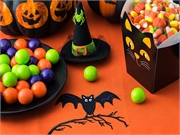- Navigating Your Midlife Crisis: Embracing New Possibilities
- City Raccoons Showing Signs of Domestication
- Mapping the Exposome: Science Broadens Focus to Environmental Disease Triggers
- One Week Less on Social Media Linked to Better Mental Health
- Your Brain Changes in Stages as You Age, Study Finds
- Some Suicide Victims Show No Typical Warning Signs, Study Finds
- ByHeart Formula Faces Lawsuits After Babies Sickened With Botulism
- Switch to Vegan Diet Could Cut Your Greenhouse Gas Emissions in Half
- Regular Bedtime Does Wonders for Blood Pressure
- Dining Alone Could Mean Worse Nutrition for Seniors
Holidays Can Be a Fright for Kids With Food Allergies

Parents of kids with food allergies probably won’t be surprised to hear that Halloween is an especially risky time for their youngsters.
A new study found that serious allergic reactions (anaphylaxis) triggered by peanuts jumped 85% when kids were trick or treating. Serious reactions triggered by an unknown tree nut or peanut exposure rose by 70% on Halloween compared to the rest of the year.
And the risk is similar on Easter — when kids are hopping around collecting chocolate eggs and other candy. Compared to other times, anaphylaxis from unknown nut exposure spiked 70% at Easter and there was a 60% increase in peanut-triggered anaphylaxis.
Fortunately, other holidays — including Christmas, Chinese New Year, Diwali and Eid al-Adha — didn’t seem to lead to an increase in serious reactions in kids with food allergies.
“The most common cause of anaphylaxis is food. When I was working in the emergency department, I was told [anaphylaxis] was higher on Halloween,” said study co-author Dr. Moshe Ben-Shoshan, an associate professor of allergy and immunology at Montreal Children’s Hospital and McGill University in Canada. “With this study, we wanted to establish whether there actually was an increased risk of anaphylaxis on holidays compared to the rest of the year.”
Anaphylaxis is a potentially life-threatening allergic reaction, according to the Asthma and Allergy Foundation of America. It’s treated with a shot of epinephrine (Epi-Pen, Auvi-Q).
Symptoms of anaphylaxis may include:
- Itching,
- Hives,
- Swelling of the lips, tongue or throat,
- Difficulty breathing or wheezing,
- Dizziness, possibly fainting,
- Stomach pain,
- Vomiting or diarrhea,
- Uneasy feeling.
The researchers reviewed almost 1,400 cases of anaphylaxis in four Canadian provinces between 2011 and 2020. Nearly two-thirds of the kids (median age: 5.4 years) were boys.
Besides uncovering strikingly higher rates of these serious allergic reactions from unknown nuts, peanuts or tree nuts on Halloween and Easter, the study found that anaphylaxis triggered by the same nuts was more likely in kids who were 6 years or older than in younger children.
While Halloween and Easter may look different this year because of the COVID-19 pandemic, Ben-Shoshan said parents need to stay extra vigilant on these holidays to make sure their kids with allergies stay safe.
But why just Halloween and Easter?
The researchers can’t know for sure from the study data, but these tend to be holidays where children are given candy. And, in the case of Halloween, it often comes from people who don’t know them (or about their allergies) at all.
“Vigilance is important. Have the epinephrine pen nearby and supervise your child. The risk was higher in kids 6 years and above — don’t think that an 8-year-old will always be responsible. Be aware that anaphylaxis can happen,” Ben-Shoshan said.
While the study was done in Canada, he said the findings probably also apply in other countries that celebrate Halloween and Easter, including the United States.
Dr. Maryann Buetti-Sgouros, head of pediatrics at Northern Westchester Hospital in Mount Kisco, N.Y., said they mirror what she sees in practice.
On Halloween and Easter, she said, “People give children candy that is purchased and they might not be as aware of the potential for cross-contamination. You’re less likely to give away candy on the other holidays they studied.”
Plus, on other holidays, food is often prepared by family members who are aware of the allergies, Buetti-Sgouros said.
She suggested asking anyone who brings food to holiday meals to share a list of the ingredients. She said allergens can hide in many foods, and manufacturers sometimes change the way they make a food. That means parents have to check labels every time they buy a food.
That makes Halloween a particular challenge, she said. The snack-size treats often lack allergy information.
“Be alert for any signs of food allergy,” Buetti-Sgouros said. “The symptoms could be very subtle, like an itchy lip or a tickle in the throat. Sudden vomiting should be considered a sign of food allergy. There should always be an epinephrine pen nearby.”
Both experts mentioned that on Halloween kids with food allergies can look for homes with teal-colored pumpkins on their doorstep. This signifies a household that will have safe treats for kids with food allergies.
The findings were published Sept. 21 in CMAJ.
More information
Learn more about anaphylaxis caused by food allergies from the Asthma and Allergy Foundation of America.
Source: HealthDay
Copyright © 2025 HealthDay. All rights reserved.










